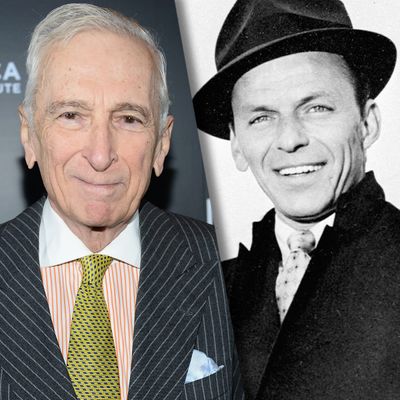
Owing to time and (lack of) effort, my intention to take notes on last nightÔÇÖs Gay Talese event at the Strand on a series of tailorÔÇÖs shirt boards ÔÇö the New Journalism pioneerÔÇÖs preferred observation medium while on assignment ÔÇö but alas, I stuck with my iPhoneÔÇÖs notebook. It was hard not to wonder, in those instances when Talese seemed to be looking straight at me (at one point or another, he seemed to be looking straight at everyone in the audience), whether I appeared to be playing video games or texting or whatever.
Looking straight at people, of course, is what Talese does ÔÇö from the sidelines, in the case of his most celebrated piece, ÔÇ£Frank Sinatra Has a Cold,ÔÇØ which he reported in 1965 and Esquire ran in April 1966. Last nightÔÇÖs soir├®e ÔÇö complete with a spread of fruit, cheese, bread, and white wine as handsome as the son-of-a-tailor authorÔÇÖs impeccable outfits ÔÇö was a celebration of art-book publisher TaschenÔÇÖs brand-new coffee-table edition of the story. It retails for $200. Perhaps weÔÇÖll soon celebrate its publication as the last time a living journalist earned $200 for a piece.
Gay Talese is an 83-year-old man who appears at least 20 years younger. Partly itÔÇÖs the dress sense: He entered the Rare Book Room in a dark blue suit with a robinÔÇÖs-egg blue kerchief, white-and-red vertical-striped shirt, and a tie, scarf, and rakishly angled hat, all yellow, removing the hat and scarf before getting on StrandÔÇÖs big comfy chair next to interviewer David Brancaccio from NPRÔÇÖs ÔÇ£Marketplace.ÔÇØ Talese made sport of his age several times. Early, thanking the Strand, he explained: ÔÇ£I was given a limousine the size of a yacht,ÔÇØ adding that he ÔÇ£slept half ofÔÇØ the hour-long ride to the bookstore.
Peering out, Talese noted, If there were older people in this room  and I see none  He exaggerated, but not by much. Talese generally, and Frank Sinatra Has a Cold in particular, has been singled out  Esquire, more than once, has called it the greatest story in the magazines history, while the New York Times named it a canonical archetype of the  New Journalism  and passed down and taught to J school classes so much in the 50 years since its publication that its taken on an august reputation quite apart from its author, even if, as Talese said, it was taken at the time as just another piece.
In short, TaschenÔÇÖs buffed-up, blown-out reprint ÔÇö complete with TaleseÔÇÖs own storyboards, original manuscripts, and related correspondence ÔÇö is the equivalent of, to choose another December-released jumbo reissue, RhinoÔÇÖs new six-CD boxed set of outtakes, alternates, live versions, and 5.1 surround mix (I donÔÇÖt know what that means either) of Fleetwood MacÔÇÖs Tusk. If you can beef up a classic album with all kinds of gewgaws, why canÔÇÖt you do the same with a classic piece of writing? ItÔÇÖs the logical next step, too, from TaschenÔÇÖs extensive trade in music-related books, such as Rock Covers and Funk & Soul Covers. At least to some degree, that is: ÔÇ£Frank Sinatra Has a ColdÔÇØ is limited to five thousand copies signed by Talese.
If youÔÇÖve read a few interviews with Talese ÔÇö and it was clear that everyone in the room had ÔÇö not a lot of what he had to say was news, for much the same reason you donÔÇÖt attend ÔÇ£Fleetwood Mac Presents an Evening of TuskÔÇØ to hear them play ÔÇ£Little Lies.ÔÇØ Besides, the stories youÔÇÖve read elsewhere ÔÇö from Talese ÔÇ£learn[ing] about ordinary lifeÔÇØ as the son of shopkeepers, about his awe at his co-workers at the New York Times (in particular drama critic Brooks Atkinson, whose handwriting was so neat, and whose first drafts were so spotless, that the paper would set type from his scribbled notes), about his his long-standing journalistic credo (ÔÇ£The art of hanging out is what itÔÇÖs all aboutÔÇØ), and about Harold Hayes, EsquireÔÇÖs fearless leader in its primo years, sending Talese to L.A. for the Sinatra interview with the words, ÔÇ£ItÔÇÖll be easy.ÔÇØ He even brought out some of the index-card-size shirt boards he uses for note-taking. You may have known the words, but thereÔÇÖs nothing like being in the room with the guy who said them first, and still says them like theyÔÇÖre new.
He added a few things, too, sometimes via a small unused detail or simple turn of phrase, like the ÔÇ£courtly indiscretionÔÇØ of Arthur Ochs-Sulzberger Sr., the TimesÔÇÖ publisher when Talese was there, as he eyeballed a young female employee across the room. When Sinatra confronted the young screenwriter and later science-fiction giant Harlan Ellison in a poolroom ÔÇö the scene at the heart of ÔÇ£Has a ColdÔÇØ ÔÇö he actually said the Ellison-penned movie The Oscar was ÔÇ£a piece of shit,ÔÇØ not ÔÇ£a piece of crap,ÔÇØ as he rendered it in Esquire. Neither Sinatra nor anyone from his camp ever responded to the feature, Talese said. Nor did he ever actually speak with Frank: ÔÇ£If heÔÇÖd said, ÔÇÿLetÔÇÖs get some pasta together,ÔÇÖ I wouldnÔÇÖt know what to ask him.ÔÇØ
Brancaccio had a few questions, though it seemed like fewer than he intended to ask: For all his stay-in-the-background mien, Talese is a yakker. He knows it, too; several times Talese put his hand on the hostÔÇÖs hand and wrist, as if to tell him, DonÔÇÖt worry, IÔÇÖm not going off the rails. At one point Brancaccio subtly began to prompt Talese, who responded, ÔÇ£IÔÇÖm sorry IÔÇÖm holding you up.ÔÇØ Not that Talese was above interrupting himself; as he ruminated over the storyÔÇÖs history, he righted his tone by noting, ÔÇ£ThereÔÇÖs a $200 book IÔÇÖm supposed to be trying to sell.ÔÇØ
When the evening finished, a woman sitting behind me tapped my shoulder. SheÔÇÖd tried to get a photo of Gay and his shirt boards, without luck, but noticed IÔÇÖd gotten one. Could I text it to her? I could. Got that, Taschen? Call anytime.

